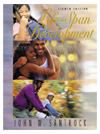 |  Life-Span Development, 8/e John W. Santrock,
University of Texas - Dallas
Beginnings Prenatal Development and Birth
Chapter ObjectivesI.Describe the germinal, embryonic, and fetal periods of prenatal development |
 |  |  | II.Define placenta and umbilical cord, and describe how they prevent the transmission of harmful substances from mother to infant. |
 |  |  | III.Define organogenesis and explain its importance. |
 |  |  | IV.Understand how cultural beliefs affect the experience of pregnancy. |
 |  |  | V.Describe the effects that drugs can have on the unborn child. |
 |  |  | VI.Discuss maternal diseases and conditions that influence prenatal development such as rubella, syphilis, herpes, and HIV/AIDS. |
 |  |  | VII.Explain how maternal and paternal characteristics affect prenatal development. |
 |  |  | VIII.Describe the three stages of birth. |
 |  |  | IX.State what researchers know and do not know about the effects of drugs administered during childbirth. |
 |  |  | X.Contrast the different childbirth strategies, noting the pros and cons of each. |
 |  |  | XI.Define and distinguish between preterm infants and low-birthweight infants. |
 |  |  | XII.Describe the two most widely used measures of neonatal health and responsiveness. |
 |  |  | XIII.Describe the physical, emotional, and psychological adjustments women have to make after pregnancy. |
|



 2002 McGraw-Hill Higher Education
2002 McGraw-Hill Higher Education